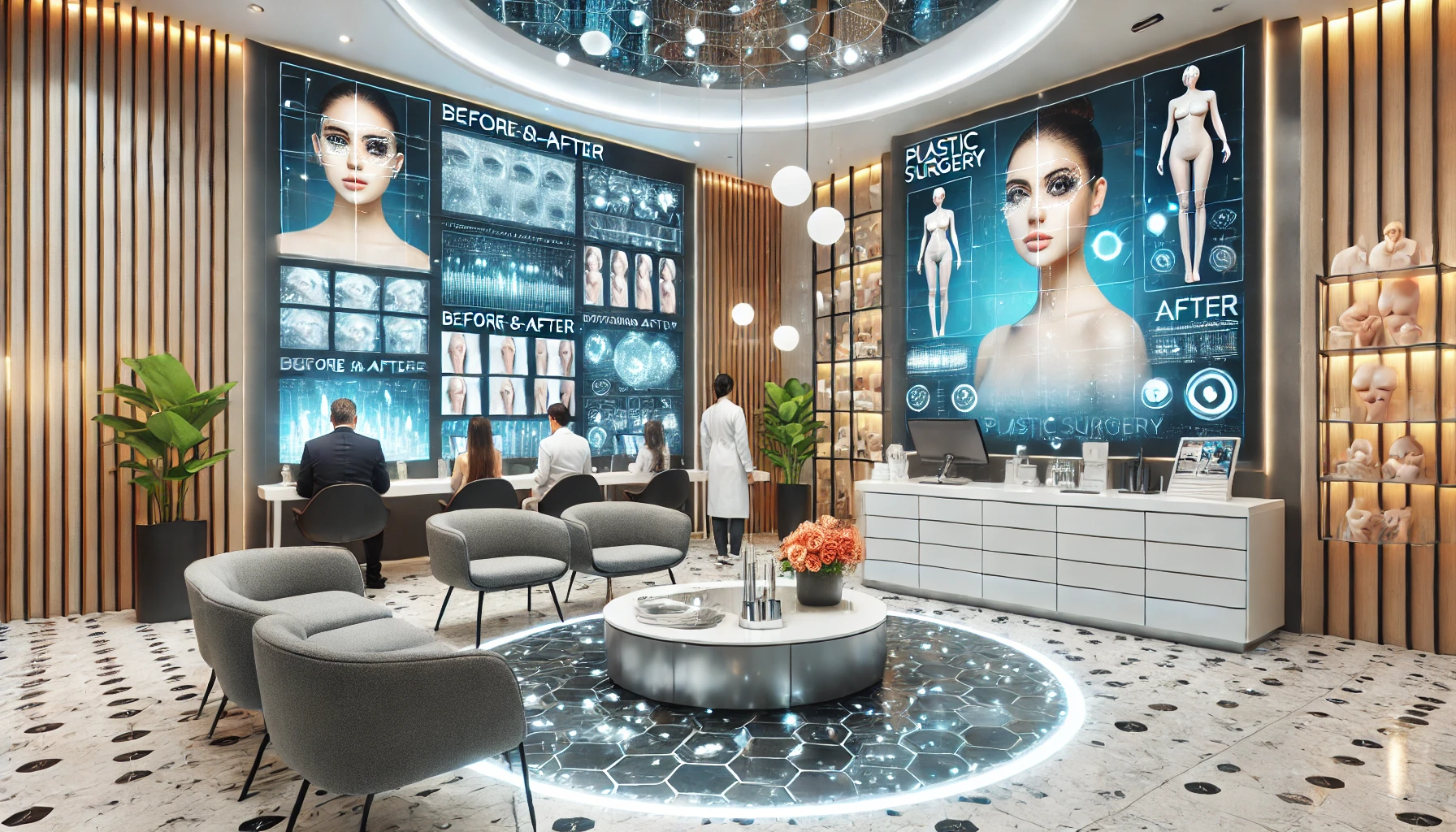Are you a plastic surgeon looking to enhance your visibility and attract more clients? In today’s competitive market, promoting plastic surgery services through targeted advertising has become essential. With the global plastic surgery market projected to reach $48.84 billion by 2026, leveraging effective advertising strategies can significantly boost your practice’s growth.
Imagine reaching potential clients who are actively searching for the services you offer. Targeted advertising allows you to do just that by tailoring your messages to specific demographics and interests. This approach not only increases your visibility but also ensures that your marketing efforts resonate with those most likely to seek your services.
At CETV, we understand the unique challenges faced by plastic surgeons. Our mission is to help businesses like yours stand out in a crowded market. By utilizing our innovative TV advertising solutions, you can reach your audience in high-traffic commercial environments, ensuring that your ads are seen and remembered.
In this blog post, we’ll explore the most effective strategies for promoting plastic surgery services through targeted advertising. From understanding your ideal patients to leveraging social media and search engine optimization, we’ll provide actionable insights to help you connect with your audience and grow your practice.
Ready to take your advertising efforts to the next level? Let’s dive into the world of targeted advertising and discover how it can transform your plastic surgery practice.
Understanding Your Target Audience
Identifying and understanding your ideal clients is the cornerstone of any successful advertising campaign. When promoting plastic surgery services through targeted advertising, it is crucial to delve into the demographics, needs, and motivations of typical plastic surgery patients. By creating detailed patient personas, you can tailor your advertising efforts effectively and ensure that your message resonates with the right audience.
Demographics of Plastic Surgery Patients
Plastic surgery patients come from diverse backgrounds, but certain demographic trends are evident. According to the American Society of Plastic Surgeons, the majority of patients seeking cosmetic procedures are women, accounting for approximately 92% of all procedures. Age-wise, patients range from 18 to 70 years old, with a significant number of individuals in their 30s and 40s opting for procedures like breast augmentation and liposuction.
Income levels also play a role in the likelihood of undergoing plastic surgery. Higher-income individuals are more likely to afford elective procedures. However, financing options and payment plans have made plastic surgery more accessible to a broader range of income groups.
Needs and Motivations
Understanding the needs and motivations of your target audience is essential for crafting compelling advertising messages. Common motivations for seeking plastic surgery include:
- Enhancing Physical Appearance: Many patients seek procedures to improve their physical appearance, boost self-confidence, and achieve a desired look.
- Correcting Physical Imperfections: Some individuals undergo plastic surgery to correct congenital disabilities, injuries, or other physical imperfections.
- Anti-Aging Treatments: Procedures like facelifts and Botox injections are popular among middle-aged patients looking to reduce signs of aging.
- Reconstructive Surgery: Patients who have undergone trauma or medical treatments, such as mastectomies, often seek reconstructive surgery to restore their appearance.
Creating Detailed Patient Personas
Developing detailed patient personas is a powerful tool for understanding your target audience. A patient persona is a fictional representation of your ideal patient, based on real data and insights. Here is an example of a patient persona for a plastic surgery practice:
By creating such personas, you can better understand your patients’ needs, preferences, and pain points, allowing you to tailor your advertising messages to resonate with them effectively.
Leveraging Audience Insights for Effective Advertising
Once you have a clear understanding of your target audience, you can leverage this information to create more effective advertising strategies. Here are some tips for promoting plastic surgery services through targeted advertising:
- Segment Your Audience: Divide your audience into segments based on demographics, needs, and motivations. This allows you to create personalized messages for each segment.
- Use Visual Content: Utilize before-and-after photos, videos, and testimonials to showcase the results of your procedures. Visual content is highly engaging and can build trust with potential patients.
- Highlight Benefits: Emphasize the benefits of your services, such as improved appearance, enhanced self-confidence, and expert care. Address common concerns and provide reassurance.
- Utilize Social Media: Platforms like Instagram and Facebook are ideal for reaching potential patients. Share informative content, engage with your audience, and run targeted ads to increase visibility.
- Optimize for Local SEO: Ensure your website is optimized for local search terms, such as “plastic surgeon in [city name].” This helps attract patients searching for services in your area.
Case Study: Successful Targeted Advertising Campaign
Consider the case of a plastic surgery practice in Miami that successfully implemented a targeted advertising campaign. By leveraging detailed patient personas and focusing on the specific needs and motivations of their audience, they achieved impressive results. The campaign included:
- Targeted Social Media Ads: Ads were tailored to different audience segments, showcasing relevant before-and-after photos and patient testimonials.
- Engaging Content: The practice shared informative blog posts and videos addressing common concerns and questions about plastic surgery.
- Local SEO Optimization: The website was optimized for local search terms, resulting in higher visibility and increased website traffic.
As a result, the practice saw a significant increase in consultation bookings and patient inquiries, demonstrating the power of understanding and targeting the right audience.
Understanding your target audience is crucial for promoting plastic surgery services through targeted advertising. By delving into the demographics, needs, and motivations of your ideal patients and creating detailed patient personas, you can tailor your advertising efforts effectively and achieve better results. For more insights and strategies on promoting your plastic surgery practice, explore our other articles on CETV Now.
Crafting Compelling Advertising Messages
Creating engaging and persuasive advertising messages is essential for attracting potential clients. This section explores best practices for crafting messages that resonate with your target audience, emphasizing benefits and using emotional appeals effectively.
Elements of a Compelling Advertising Message
To craft compelling advertising messages, it is essential to focus on several key elements:
- Clear and Concise Language: Use straightforward language that is easy to understand. Avoid jargon and complex terms that may confuse potential clients.
- Strong Value Proposition: Clearly communicate the unique benefits and value of your plastic surgery services. Highlight what sets you apart from competitors.
- Emotional Appeal: Tap into the emotions of your audience by addressing their desires, fears, and motivations. Emotional connections can significantly enhance the persuasiveness of your message.
- Call to Action (CTA): Encourage potential clients to take action by including a clear and compelling CTA. Whether it’s scheduling a consultation or visiting your website, make the next steps obvious and easy.
Examples of Effective Ad Copy
Looking at successful advertising campaigns can provide valuable insights into what works. Here are a few examples of effective ad copy from the industry:
- Before-and-After Transformations: “See the amazing transformations our patients have experienced. Book your consultation today and take the first step towards a more confident you!”
- Testimonials: “Our patients love their results! ‘I couldn’t be happier with my new look. The team was professional and caring throughout the entire process.’ – Jane D.”
- Special Offers: “Limited-time offer: Get 10% off your first procedure. Contact us now to schedule your appointment and start your journey to a new you!”
Importance of Emotional Appeals and Benefits-Focused Messaging
Emotional appeals and benefits-focused messaging are critical components of effective advertising. Here’s why:
Emotional Appeals: Emotions drive decision-making. By addressing the emotional needs and desires of your audience, you can create a deeper connection and motivate them to take action. For example, highlighting how a procedure can boost self-confidence or improve quality of life can resonate strongly with potential clients.
Benefits-Focused Messaging: Instead of just listing features, focus on the benefits that your services provide. Explain how your procedures can solve specific problems or enhance the lives of your clients. For instance, “Achieve a youthful appearance and regain your confidence with our expert facelift procedures.”
Actionable Tips for Creating Compelling Messages
Here are some actionable tips to help you create compelling advertising messages:
- Know Your Audience: Understand the demographics, needs, and motivations of your target audience. Tailor your messages to address their specific concerns and desires.
- Use Visuals: Incorporate high-quality images and videos that showcase your work. Visual content can capture attention and convey your message more effectively.
- Be Authentic: Authenticity builds trust. Use genuine testimonials and real before-and-after photos to demonstrate the effectiveness of your services.
- Test and Optimize: Continuously test different ad copies and visuals to see what resonates best with your audience. Use data and feedback to refine your messages and improve performance.
By focusing on these elements and strategies, you can craft compelling advertising messages that effectively promote your plastic surgery services and attract more clients. For more insights and strategies, explore our other articles on CETV Now.
Choosing the Right Advertising Channels
Selecting the most effective advertising channels is crucial for reaching your target audience. This section will examine various channels, including social media, search engines, and traditional media, and provide insights on how to leverage each for maximum impact.
Social Media Advertising
Social media platforms like Facebook, Instagram, and LinkedIn offer unique opportunities to connect with potential clients. These platforms allow for highly targeted advertising based on demographics, interests, and behaviors.
Pros:
- Highly targeted: Social media platforms provide advanced targeting options, allowing you to reach specific demographics and interests.
- Engaging content: Visual content, such as before-and-after photos and videos, can be highly engaging and effective in promoting plastic surgery services.
- Cost-effective: Social media advertising can be more affordable compared to traditional media, with options to set daily budgets and control spending.
Cons:
- Ad fatigue: Users may become desensitized to ads if they see them too frequently, leading to decreased effectiveness.
- Platform changes: Social media algorithms and policies can change, impacting the reach and performance of your ads.
For example, a plastic surgery practice in Miami successfully used Instagram ads to showcase before-and-after photos of their procedures. By targeting women aged 25-45 in the Miami area, they saw a significant increase in consultation bookings.
Search Engine Advertising
Search engine advertising, such as Google Ads, allows you to reach potential clients actively searching for plastic surgery services. This can be highly effective for capturing high-intent leads.
Pros:
- High intent: Users searching for plastic surgery services are likely to be further along in the decision-making process.
- Measurable results: Search engine ads provide detailed analytics, allowing you to track conversions and optimize your campaigns.
- Local targeting: You can target ads to specific geographic locations, ensuring you reach potential clients in your area.
Cons:
- Cost: Competitive keywords can be expensive, especially in the plastic surgery industry.
- Ad blindness: Some users may ignore paid search results, focusing only on organic listings.
A successful campaign example is a Dallas-based plastic surgery clinic that used Google Ads to target keywords like “rhinoplasty Dallas” and “liposuction Dallas.” By optimizing their ad copy and landing pages, they achieved a high conversion rate and increased their patient inquiries.
Traditional Media Advertising
Traditional media channels, such as television, radio, and print, can still play a role in a comprehensive advertising strategy. These channels can help build brand awareness and reach a broad audience.
Pros:
- Wide reach: Traditional media can reach a large and diverse audience, increasing brand visibility.
- Credibility: Being featured in traditional media can enhance the perceived credibility of your practice.
- Impactful: High-quality TV commercials or print ads can leave a lasting impression on viewers.
Cons:
- Cost: Traditional media advertising can be expensive, especially for prime-time TV spots or full-page magazine ads.
- Limited targeting: Traditional media lacks the precise targeting options available with digital advertising.
For instance, a plastic surgery practice in Phoenix used local TV commercials to promote their services. By featuring patient testimonials and showcasing their state-of-the-art facilities, they built trust and attracted new clients.
Multi-Channel Strategies
Combining multiple advertising channels can create a more robust and effective marketing strategy. A multi-channel approach ensures that you reach potential clients at various touchpoints, increasing the likelihood of conversion.
Benefits of Multi-Channel Strategies:
- Increased reach: Utilizing multiple channels allows you to reach a broader audience.
- Consistent messaging: A cohesive multi-channel strategy ensures consistent messaging across all platforms.
- Improved ROI: By diversifying your advertising efforts, you can optimize your budget and improve overall ROI.
For example, a plastic surgery clinic in Scottsdale implemented a multi-channel strategy that included social media ads, Google Ads, and local radio spots. This comprehensive approach resulted in a significant increase in patient inquiries and consultations.
Conclusion
Choosing the right advertising channels is essential for promoting plastic surgery services effectively. By understanding the pros and cons of each channel and leveraging a multi-channel strategy, you can maximize your reach and attract more clients. For more insights and strategies on promoting your plastic surgery practice, explore our other articles on CETV Now.
Measuring and Optimizing Your Advertising Campaigns
Continuous measurement and optimization are key to the success of any advertising campaign. This section will explore the metrics to track, tools to use, and strategies for refining your campaigns based on performance data. By understanding these elements, you can enhance your efforts in promoting plastic surgery services through targeted advertising.
Key Performance Indicators (KPIs) for Advertising
To effectively measure the success of your advertising campaigns, it is essential to track key performance indicators (KPIs). These metrics provide insights into how well your ads are performing and where improvements can be made. Here are some crucial KPIs to consider:
- Click-Through Rate (CTR): This metric measures the percentage of people who click on your ad after seeing it. A higher CTR indicates that your ad is engaging and relevant to your audience.
- Conversion Rate: This KPI tracks the percentage of visitors who take a desired action, such as booking a consultation or filling out a contact form. It helps evaluate the effectiveness of your ad in driving conversions.
- Cost Per Click (CPC): CPC measures the amount you pay each time someone clicks on your ad. Monitoring this metric helps manage your advertising budget and optimize spending.
- Return on Ad Spend (ROAS): ROAS calculates the revenue generated from your advertising efforts compared to the amount spent. A higher ROAS indicates a more profitable campaign.
- Impressions: This metric shows how often your ad is displayed. While impressions alone do not indicate success, they provide context for other KPIs.
Tools and Methods for Tracking Performance
Utilizing the right tools and methods is crucial for accurately tracking and analyzing your advertising performance. Here are some recommended tools and techniques:
- Google Analytics: This powerful tool provides detailed insights into website traffic, user behavior, and conversion tracking. It helps you understand how visitors interact with your site after clicking on your ads.
- Facebook Ads Manager: For campaigns on Facebook and Instagram, Ads Manager offers comprehensive analytics on ad performance, audience engagement, and conversion tracking.
- Google Ads: Google Ads provides robust reporting features, allowing you to monitor KPIs such as CTR, CPC, and conversion rates. It also offers tools for A/B testing and optimization.
- Heatmaps: Tools like Hotjar and Crazy Egg create visual representations of user interactions on your website. Heatmaps help identify areas where users engage most and highlight potential issues in the user experience.
- Customer Relationship Management (CRM) Systems: CRMs like HubSpot and Salesforce track leads, customer interactions, and conversions, providing valuable data for optimizing your campaigns.
The Importance of A/B Testing and Continuous Optimization
A/B testing is a critical component of optimizing your advertising campaigns. By comparing two versions of an ad or landing page, you can determine which performs better and make data-driven decisions. Here’s how to implement A/B testing effectively:
- Define Your Hypothesis: Start with a clear hypothesis about what you want to test. For example, you might hypothesize that changing the call-to-action (CTA) text will increase conversion rates.
- Create Variations: Develop two versions of your ad or landing page, each with a single variable changed. This could be the headline, image, CTA, or any other element.
- Split Your Audience: Divide your audience into two groups, ensuring each group is exposed to one version of the ad or landing page.
- Analyze Results: Monitor the performance of each version using your KPIs. Determine which version performs better and implement the winning variation.
- Iterate and Optimize: Continuous optimization involves repeating the A/B testing process with new variables. This iterative approach helps refine your campaigns over time.
Continuous optimization is not limited to A/B testing. Regularly reviewing your KPIs, analyzing performance data, and making adjustments based on insights are essential for maintaining successful advertising campaigns. By staying proactive and data-driven, you can ensure your efforts in promoting plastic surgery services remain effective and yield the best results.
Actionable Takeaways for Optimizing Advertising Campaigns
Here are some actionable tips to help you optimize your advertising campaigns:
- Leverage Audience Insights: Use data from your CRM and analytics tools to understand your audience’s preferences and behavior. Tailor your ads to resonate with their needs and motivations.
- Utilize Retargeting: Implement retargeting campaigns to re-engage visitors who have shown interest but did not convert. Retargeting can significantly improve conversion rates.
- Optimize Ad Copy and Creatives: Regularly update your ad copy and visuals to keep them fresh and engaging. Test different headlines, images, and CTAs to find the most effective combinations.
- Monitor Competitor Strategies: Keep an eye on your competitors’ advertising efforts. Analyze their strengths and weaknesses to identify opportunities for differentiation.
- Focus on Mobile Optimization: Ensure your ads and landing pages are optimized for mobile devices. With an increasing number of users accessing the internet via mobile, a seamless mobile experience is crucial.
By implementing these strategies and continuously measuring and optimizing your campaigns, you can effectively promote your plastic surgery services through targeted advertising. For more insights and strategies, explore our other articles on CETV Now.
Elevate Your Practice with Targeted Advertising
By now, you understand that promoting plastic surgery services through targeted advertising can dramatically enhance your practice’s visibility and attract more clients. Understanding your audience’s demographics, needs, and motivations is the first step in crafting compelling advertising messages that resonate and convert.
Creating detailed patient personas helps you tailor your advertising efforts to address specific concerns and desires, ensuring that your messages hit the mark. Leveraging social media platforms like Instagram and Facebook, where visual content thrives, can showcase your expertise and the transformative results of your procedures effectively. Additionally, optimizing your website for local SEO and using search engine advertising can capture high-intent leads actively searching for services you offer.
Choosing the right advertising channels is crucial. Social media, search engines, and traditional media each have unique advantages, and a multi-channel strategy can help you reach a broader audience. Employing continuous optimization techniques, such as A/B testing and performance tracking, ensures your campaigns remain effective and yield the best results.
Consider these key takeaways:
- Understand Your Audience: Create detailed patient personas to tailor your advertising efforts effectively.
- Leverage Visual Content: Use before-and-after photos, videos, and testimonials to build trust and engage potential clients.
- Optimize for Local SEO: Ensure your website is optimized for local search terms to attract nearby clients.
- Employ Multi-Channel Strategies: Utilize social media, search engine ads, and traditional media to maximize reach.
- Continuously Optimize: Use A/B testing and performance tracking to refine your campaigns for better results.
By embracing these strategies, you can elevate your plastic surgery practice and attract more clients. Ready to take your advertising efforts to the next level? Explore more insights and strategies on CETV Now and start transforming your practice today!
What are your thoughts? Share your experiences and questions in the comments below. Let’s continue the conversation and help each other succeed in promoting plastic surgery services through targeted advertising.









